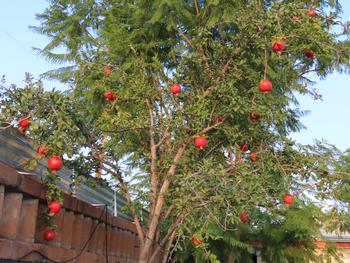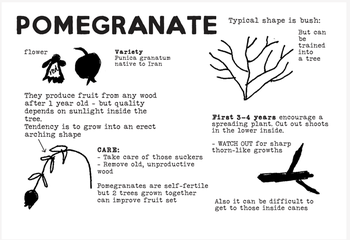Fall 2024
Pomegranates: easy, delicious, and drought-tolerant Punica granatum

History: pomegranates go back thousands of years
This gorgeous food is associated with the most ancient civilizations in the Middle East, specifically Iran and the surrounding area. Once it arrived in Greece, it became one of the first cultivated foods in the world. The pomegranate express passed through India and China next, and then on to the Mediterranean where it grew especially well in the dry heat of Spain. Spanish missionaries brought pomegranates to the New World after Cortez conquered Mexico in 1521, and as the missions began to dot California, so did pomegranate trees.
 In addition to providing tasty fruit, pomegranate trees offer shade, fall color, and drought tolerance. Photo: Chick Bee, Flickr
Cultural conditions: pomegranates love heat
In addition to providing tasty fruit, pomegranate trees offer shade, fall color, and drought tolerance. Photo: Chick Bee, Flickr
Cultural conditions: pomegranates love heat

Pomegranates relish hot, dry regions such as California’s central valley – especially if you want to encourage maximum sweetness. Doesn’t get to 105 degrees all summer in your neighborhood? It’s also an outstanding 15 to 20-foot ornamental shrub or tree for sunny but cooler areas, sporting brilliant orange-red flowers in summer, followed by leathery red globes and yellow foliage in the fall (and no leaves in winter in desert and interior regions).
Pomegranates aren’t as picky as many other fruit trees when it comes to soil. They like loam best, but sandy or clay soils will do. They even tolerate some slow drainage and alkaline soil, but growth, fruit, and yield will suffer. They appreciate a little extra nitrogen fertilizer in fall or winter. Consider planting fava beans underneath for a little nitrogen boost. As a bonus, they are pest resistant, often laughing off coddling moth and twig borers.
Pomegranates do not appreciate summer rain, which tends to soften the fruit. (Not that this is a big concern around here, of course.) Your best bet to optimize flavor is to keep soil moist during the growing season and into fall to avoid split fruit. Harvest a few weeks before full maturity in October, and definitely before the rains come, which usually results in split fruit. They last for weeks and will even darken and redden at room temperature.
 Drought? No problem.
Drought? No problem.

Given their region of origin, it’s no surprise that pomegranates can withstand long periods of drought - but don’t expect much fruit. But here’s the magic: if you start watering a pomegranate that has been subjected to many years of neglect and drought conditions, it will spring back into action and say thank you by producing an abundance of fruit. How cool is that?
Pruning: let the sunshine in
Pomegranates produce from new and old wood after one year. Aim to maximize sunlight inside the tree for best tasting fruit. For the first three or four years, encourage an open, spreading plant by cutting out shoots in the lower inside. While you’re at it, be sure to remove suckers and old, unproductive wood.
